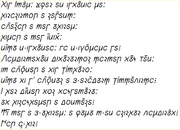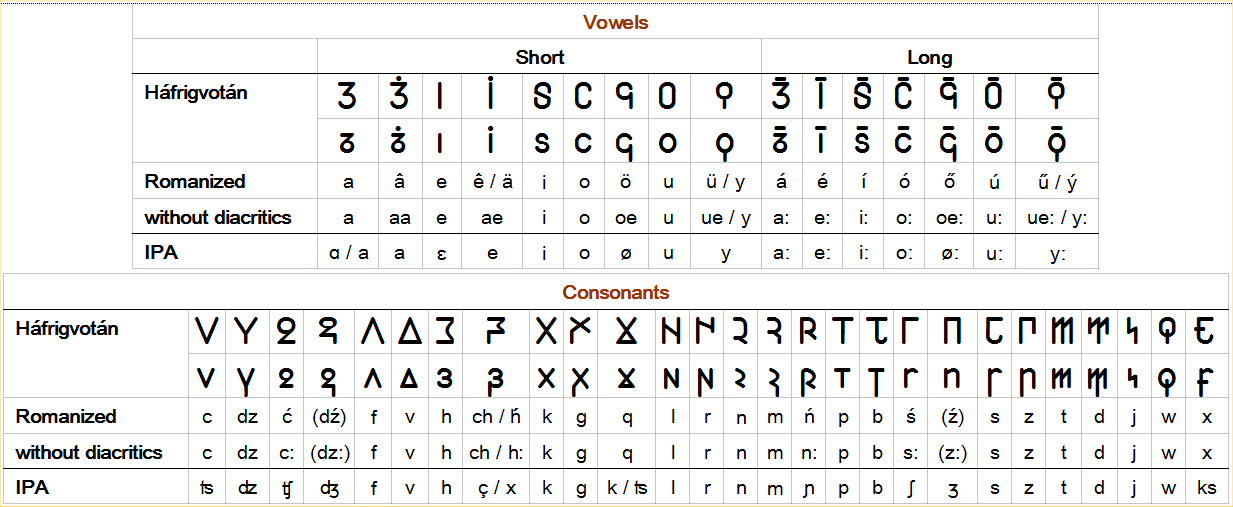If you are interested in my conlang, please write me an e-mail to the following address: repaiattila@freemail.hu
Amb iminild i mes errak, ćimbre, votiz máj a kassöśuttum i folkend uskézar: repaiattila@freemail.hu
Setting
Avorenta [ˈɒvorɛntɒ] is a constructed language created by Attila Répai in 2008. The word ’avorenta’ means ’regulated’, as it is a regulated version of its ancestor, the Háfrigerrak. Its grammar is based on the Hungarian language, therefore it is an agglutinating language. Its dictionary contains over 2100 words, most of them are ficticious, but a few derive from Turkish, Lithuanian, Latin, Germanic and Celtic languages.
- It has a logical grammar without a lot of exceptions.
- Its vocabulary can be enlarged without restraint because we can form a large amount of words with suffixes.
- Words are easy to pronounce.
- We can express long English sentences very briefly eg. 'I and you could have taken them back down to the cellar' = Ájdivvélüstivemó l-ármoga.
- We can express slight differences of importance with word order.
Basic Grammar
Pronunciation and writing system - Úcórán e votánfádach
Noun and adjective declension - Hênmis- e nilganmispégońán
- Nouns ending in a consonant (eg. hutt 'house')
- a-stem (eg. capta 'room')
- e-stem (eg. pikte 'bag')
- i-stem (eg. zülti 'thing')
- u-stem (eg. histu 'news')
- Suffixes starting with a vowel (eg. -um, -áma)
- Suffixes starting with a consonant (These suffixes also have a linking vowel, which is to be used after a consonant. (eg. -(e)n, -(é)ti)
| Case | Hungarian suffix | HGE suffix(singular) | Example | HGE suffix(plural) | Example |
|---|---|---|---|---|---|
| Nominative | - | - | hutt, capta | -e | hutte, capte |
| Accusative | -t | -um | huttum, captum | -u | huttu, captu |
| Genitive | -nak | -(i)s | huttis, captas | (i)sse | huttisse, captasse |
| Dative | -nak | -áj / -âj | huttáj, captáj | -o | hutto, capto |
| Instrumental-comitative | -val | -(e)n | hutten, captan | -(é)ne | hutténe, captáne |
| Causal-final | -ért | -ad | huttad, captad | -áde | huttáde, captáde |
| Translative | -vá | -uá | huttuá, captuá | -ué | huttué, captué |
| Terminative | -ig | -(é)ti | huttéti, captáti | -(é)te | huttéte, captáte |
| Essive-formal/modal | -ként / -ül | -oj | huttoj, captoj | -ojje | huttojje, captojje |
| Inessive | -ban | -io | huttio, captio | -eo | hutteo, capteo |
| Adessive | -nál | -ómo / -om | huttómo, captómo | -óme | huttóme, captóme |
| Superessive | -on | -óro / -or | huttóro, captóro | -óre | huttóre, captóre |
| Elative | -ból | -i | hutti, capti | -ei | huttei, captei |
| Ablative | -tól | -ími / -im | huttími, captími | -íme | huttíme, captíme |
| Delative | -ról | -íri / -ir(i) | huttíri, captíri | -íre | huttíre, captíre |
| Illative | -ba | -a | hutta, captá | -ea | huttea, captea |
| Allative | -hoz | -áma / -am | huttáma, captáma | -áme | huttáme, captáme |
| Sublative | -ra | -ára / -ar | huttára, captára | -áre | huttáre, captáre |
Verbs - Dífekke
| Indicative | Conditional | Imperative 1Subjunctive | Imperative 2 | |
|---|---|---|---|---|
| SG1 | -e | -ive | -ez | - |
| SG2 | -i | -ivi | -iz | ti- / t'- |
| SG3a (general) | - | -iv | -oz | ho- / h'- |
| SG3b (masculine) | -og | -ivog | -ogoz | hog- |
| SG3c (feminine) | -a | -iva | -az | hag- |
| PL1a (general) | -am | -ivam | -amoz | ke- / k'- |
| PL1b (SG1+SG2/PL2) | -em | -ivem | -emoz | ken- |
| PL1c (SG1+SG3/PL3) | -um | -ivum | -umoz | kun- |
| PL2 | -in | -ivin | -inz | du- / d'- |
| PL3 | -est | -ivest | -estoz | ve- / v'- |
Dictionary
...
Example text
The Lord's Prayer

Kes Etâr, qwin il eskáleo ri,
genomentuz i missild, offimmoz i tis agenir, geroz i tis élekk,
léda l-eskálio, śo l-edzúroro si.
Forventikál vekánandum dontiz káj píl,
et offűliz i kes bêtgánu,
léda ke s’ offűlam i h-inóvand bêtdífendo.
E gin véliz kum kojsitána,ak gemojgiriz i vultími.
(Dé tis i h-agenir, i wara t-il omengan forvenâk.)
Roz ö-gen.
The Magical Deer (Ancient Hungarian legend) - I vinturbaraus fába
- Isteró ha tikkor, ćo fillogonn gefinestó, het i zébio ha jauvos śinnabarau riltó h-ápüst. La texadó h‑ápüsti, ve pêdze hi meotizál pengale pitta si folkestó. Hatt ö‑lapti h‑elónat farswin, e doz mőrti aradestó, h-édańńa son genógaldestó. Táńővestó l‑óle völlé pengalu he ves ájfilisse holozavoltiránar ekarináj nógestó. Foropti ves etâram ájrowix gekátest hí hi restánum, forven zültüsten i meotizál pengale pitta rowestó, ćo h‑ájfilüstu holozavoltirix hatt bíledz.
- I Meotizis tirlün Perśias lenn gűre nógand; an wádus exeloren vilqveni múr éliohaff, gan ájd ö‑robendu, ak batále holozáta fêllüreo, h‑aćorreo, fozeo, h‑áfeo he fillogeo; i táń- et átőván ante tefig. I meotizál pengale pitta rowestó fixi, e fim pellti gan ollíkiltestó hatti. Ênnil i six pellio h-átfimmestó, i zébio damöwájnat i Bereka-zígisse bênáre he pelláre nágest, laqwine hi maune h-aur tagâlonstó, et évas i bórdis córnibálum sovitest e cerdára bêdlonstó. Ájfilüsten maurat avellat ovvélestó veum i Meotizis pengaleo. I bós ö-flet opti hett ró hil anx ö-śommeg.
- Isteró pêdze, ćo h‑illio h‑eltoppio le pelle pitte l-alán wariónis, Dulánis dau pellinum êś ohhaffestó, anigum Hunor, i h‑elongum Magor lájmó bênoj. Illei minnei dévizó lapti hi ven hún e hunnâs. Isteró pêdze, ćo lapti mőrti baulest i meotizál pengale pitte, úzestó bêre bós foxuá gőten, et y tirlün óle gin tákümben, gin avoltiren gan ö-ró bonnu veum.

